
SaGa Scarlet Grace: Ambitions Review
SaGa Scarlet Grace surprised me. I had imported the 2016 Japan-only Vita version a few years back, and enjoyed what I played of it then, but ended up putting it on my backlog for a bit when the start of 2017 came and dominated my wallet and playtime. What I'd played told me I would probably enjoy the game once I finally got around to playing it, but that time simply didn't come to fruition, and by the time I was interested in coming back to it series creator Akitoshi Kawazu more than hinted that the title would come west somewhere down the line. So, I've been waiting to dig my teeth in.
That time finally came with the game's western release as SaGa Scarlet Grace: Ambitions, a localized version of the updated PlayStation 4, PC, Switch and mobile versions of the game. Square Enix added a few QoL changes, a little bit of extra content, and an opening movie (well, on PS4 and Switch at least - the PC version also comes with the opening, but only as a file in the game's folders for some asinine reason). To my surprise, the title's localization was handled by the always fantastic 8-4 and even came with an English dub for the game's few voiced lines and battle cries. Players even have the option to choose how expressive these voices should be at the start of the game!
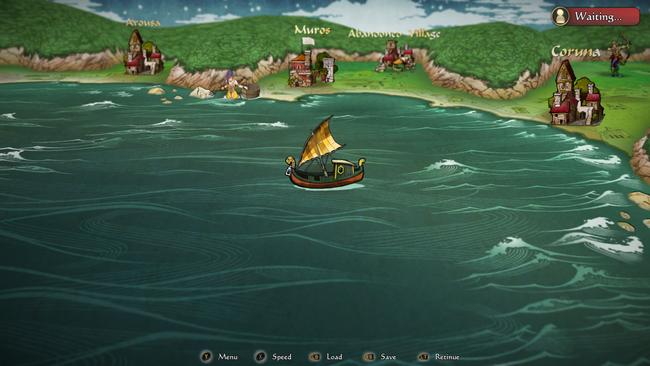
SaGa Scarlet Grace's main gimmick as an RPG is a complete lack of explorable dungeons and towns. The vast, vast majority of the game just takes place on the world map. However, there are no random encounters. Each of the world's numerous regions is dotted with points of interest, which can house events and battle encounters. At first, this seems restricting - but the game makes full use of this system to constantly have the world evolve. Whether it might be beehives that grow over time on the western side of the continent, puzzles surrounding which coal to set a lighthouse ablaze on the eastern side, to everything in between. Crucially, these decisions can and do have an impact on both the story as well as come with unique conclusions to each of their own sidequests.
Players are rewarded for listening to Minstrels in town menus, which are one of a few methods for figuring out how each of the game's various regions works in the grand scheme of the game as a whole. They almost feel like their own self-contained puzzles - some more engaging than the rest, but each with their own gimmicks and unique locales that really help cement the area in your memory, despite the very low fidelity of everything around you. It's certainly the type of game where you'll have to fill in the blanks for yourself, but despite at least part of this obviously being a budgetary constraint - I think it works in the game's favor, and the painterly aesthetic mixed with the pop-up book styled points of interest really do sell the game's world as being a grand, fairy tale of some sort.
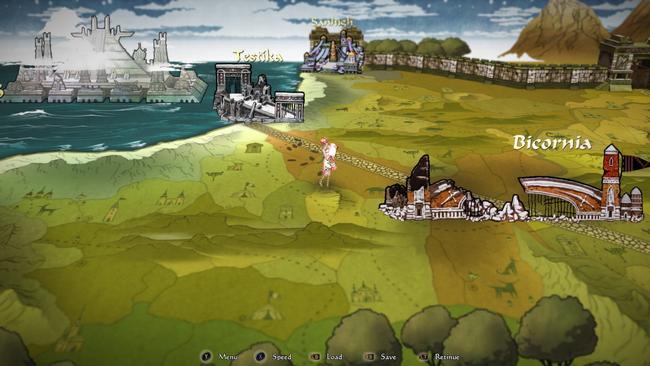
While the game's visuals might be an acquired taste, the soundtrack is consistently fantastic. Each of the game's 4 playable protagonists has their own field and standard battle themes, and all of them are a joy to listen to. Certain special fields and battle encounters will have their own unique themes that are the same for every playthrough, and those sound fantastic too. One of my favorite tracks in the entire game is a music box rendition of the opening movie's theme that plays in the various markets dotting the central city of Azhuacan. It's a hauntingly somber tune and fits the locale beautifully.
SaGa Scarlet Grace's combat is also consistently fantastic, and may just be my favorite turn-based battle system of all time at this point. Each turn your party has access to a set number of BP - Battle Points - and these points are used whenever a party member acts using a Tech. Different actions have different BP costs - generally, the stronger the Tech, the more expensive the BP requirement. As you continue to use a Tech, it will level up, which both makes it a little stronger as well as reduces the BP cost for the action. Different party formations come with their own buffs and debuffs, and can also change how many BP your party starts with, how and when they get more (most formations will award you 1 extra BP per turn into the encounter), how many BP you'll have access to at max power, and more.

The BP system is already interesting enough on its own, but it really shines once you've got multiple enemies on the screen and have to contend with taking advantage of United Attacks and the Timeline system.
Much like many other turn-based RPGs these days, characters and enemies attack based on turn order. However, Scarlet Grace puts a bit of a wrinkle in things with United Attacks. If you kill an enemy that's wedged between two of your party members on the timeline, then assuming they still die between those party members, you'll activate a United Attack between them. Each party member that's now connected together due to vanquishing the enemy will band together for an attack and all get their go at another enemy on the Timeline. If you're especially lucky, they'll kill another enemy wedged between two party members which will, in turn, activate another United Attack anew.
You want to go for United Attacks, with few exceptions, whenever you can. Not only does it deal a nice chunk of damage to enemies, but every party member that ended up participating in the United Attack gets a reduced BP cost for their Techs in the next turn. The strength of the discount depends on their skill level with their chosen weapon, but some ultra-powerful Techs can only really be used after reducing a character's BP costs - they're simply more expensive than your max BP allotment. The game's combat is at its best when you're quelling an enemy's counter/interrupt with a ranged attack, setting up a chain of United Attacks, and either finishing on a United Attack or an ultra-powerful Tech that essentially nukes the battlefield clean.
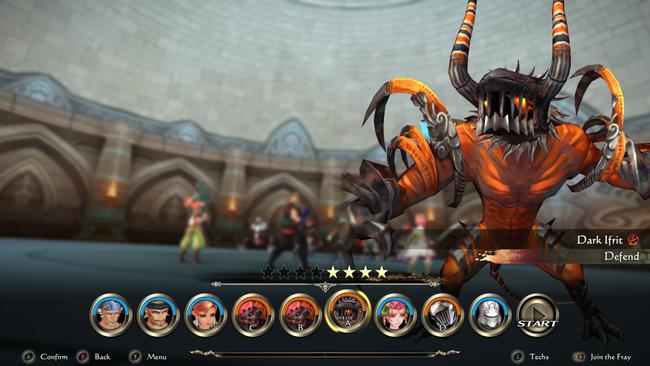
There's a lot more to the battle system that makes this easier said than done. Like I just mentioned, Counters and Interrupts are something that players will have to contend with. Both your characters (depending on their class, and whichever Techs they've Sparked from their weapon of choice) and enemies can use these, and they can spell trouble if you want to manage an encounter as cleanly as possible. Most of these counters/interrupts can be Quelled with a ranged attack to the enemy readying the Tech in question - any enemy readying one of these will have three question marks above their icon on the timeline, making it easy to tell when you'll have to consider quelling them.
Of course, with the Timeline system being as it is, and how Interrupts and Counters can adjust positions on the timeline, it might be useful for players to consider using these Techs for themselves. Then you have Techs with special attributes like Confusion, Stun, Paralyze, Poison, Sleep, and Provoke. Scarlet Grace is one of those scant few RPGs where each of these attributes actively feels like they have their place, and stuff like Poison particularly can be a great method of melting a bulky boss' HP since it deals damage as a percentage and not a flat number.
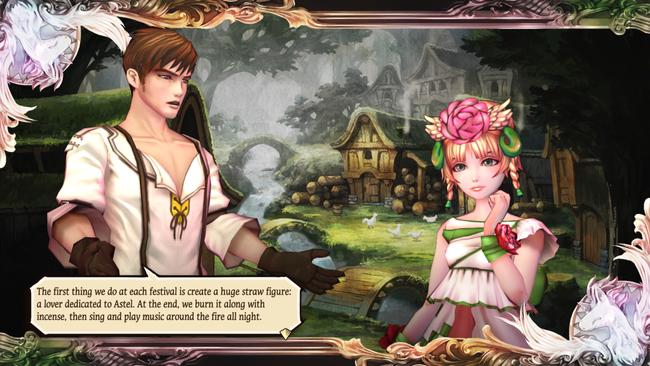
In general, Scarlet Grace does an excellent job at letting each playthrough feel unique, and your own. Each of the 4 playable characters has a slightly different game flow - some like Urpina and Taria are the most standard, and deal with the world's backstory and plot that might make other characters' stories more interesting in context. Leonard is essentially open-ended from the word go and lets players experience everything at their own pace in a freeform adventure. Meanwhile, Balmaint's story is incredibly restrictive and linear - forcing players to have a succinct understanding of what they want their party to look like from the offset.
There's a side activity called Production, completely missable, that essentially has you facilitating trade between the games' regions. While you do receive some materials which can go towards weapon and armor upgrades for doing this, the main reason I see for spending time with it is the fascinating amount of worldbuilding that comes attached to the thing. As you're helping these regions expand trade, and the world's culture develops as you go, you're treated to tidbits about the product in question - the effort that goes into making it, where you can take it to next, and more. Occasionally, as you continue to help each specific region, you begin to learn more about the struggles that everyday folks contend within their specific regions.
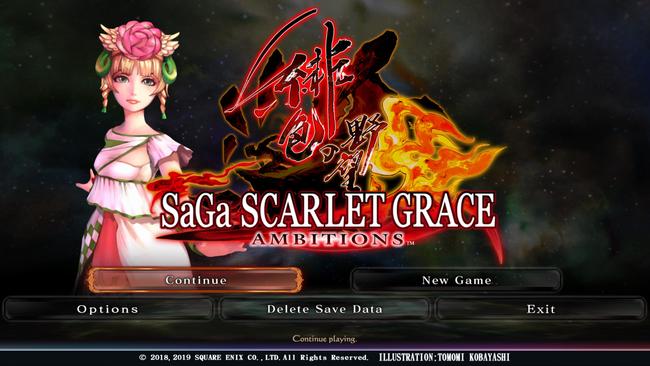
SaGa Scarlet Grace is an RPG that took a lot of risks, to be sure, but the end result is a fascinating RPG that you won't truly find anywhere else - one that you owe it to yourself to play. Even SaGa's normally obtuse nature isn't nearly as much of a barrier this time around, as the game comes included with Tips that can help you get started with the world. Scarlet Grace is easily the best RPG I've played this year, and might just be the most memorable game that I've played in a very long time.